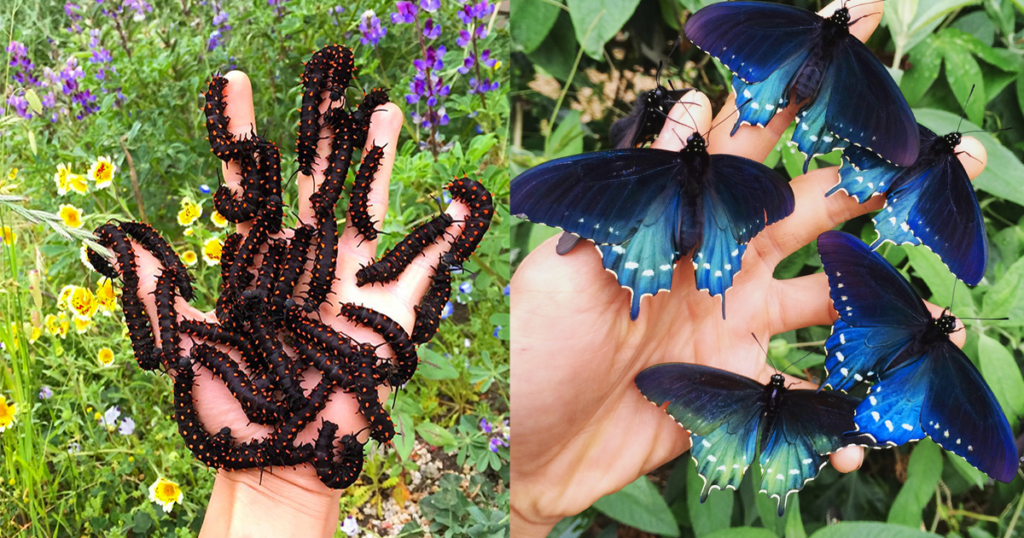In the early 20th century, the vibrant blue California pipevine swallowtail butterflies were abundant in San Francisco. However, due to urban development, their numbers started to decline, and they became a rare sight. Fortunately, Tim Wong, a 28-year-old aquatic biologist at the California Academy of Sciences, took it upon himself to repopulate this beautiful creature, single-handedly, in his own backyard.

Considered the most magnificent butterfly species in North America, collectors highly value the wings of the California pipevine swallowtail, scientifically known as Battus philenor hirsuta. These butterflies undergo a fascinating life cycle, starting as small red eggs that hatch into large orange-speckled caterpillars. After a gestation period of up to two years, they emerge as beautiful blue butterflies shimmering with oceanic hues.
While Wong’s regular job involves caring for 38,000 animals, including albino alligators, Japanese stingrays, and octopuses at the science museum, he dedicates his free time to raising butterflies and tending to his garden. His passion for these creatures developed during his childhood when he would spend his days in an open meadow near his home, catching, studying, and raising any butterflies he could find. Wong explained, “I was first inspired to raise butterflies when I was in elementary school. We raised painted lady butterflies in the classroom, and I was amazed at the complete metamorphosis from caterpillar to adult.”

Upon learning about the declining population of the pipevine swallowtail in San Francisco, Wong made it his personal mission to bring the butterfly back. He extensively researched the butterfly and discovered that it exclusively feeds on one plant species, the California pipevine (Aristolochia californica). This plant is exceptionally rare in the city, making it challenging to find. Wong eventually located the plant in the San Francisco Botanical Garden and obtained a few clippings with permission.
Using self-taught techniques, Wong created an incredible butterfly paradise in his backyard. He built a large screen enclosure that protected the butterflies while allowing them to mate under natural environmental conditions, such as sunlight, airflow, and temperature fluctuations. This specialized enclosure provided protection from predators, increased mating opportunities, and served as a study environment to better understand the criteria female butterflies seek in their ideal host plant.

Once Wong completed his butterfly paradise, the next step was to find some caterpillars. He managed to locate a group of 20 caterpillars outside the city in private residences with abundant vegetation. He brought them back to his backyard and released them onto the pipevine plants for feeding. Wong explained, “They feed as a little army. They roam around the pipevine plant from leaf to leaf, munching on it as a group.”

About 3-4 weeks later, the caterpillar pupates and forms an outer shell known as a chrysalis. Inside the chrysalis, the insect undergoes a transformation, liquefying itself and developing into a butterfly within around two weeks or remaining dormant for up to two years. When the butterfly is in this delayed development stage, it’s called diapause. The adult pipevine butterfly typically emerges from its chrysalis in spring but can sometimes be seen flying from February to October. These creatures usually live for only two to five weeks, depending on factors such as temperature, predation, and food availability. During their short lives, females lay their eggs on the pipevine plants. Wong carefully collects these eggs in clusters of five to 30 and incubates them indoors away from predators like spiders and earwigs. He stated, “From there, the cycle continues.”

After the eggs hatch, Wong raises the caterpillars at home and then brings them to the California Native exhibit at the San Francisco Botanical Garden. He has been following this routine for years and has successfully introduced thousands of caterpillars to the garden. While other conservationists have succeeded in repopulating the pipevine butterfly in Santa Cruz and Sonoma, none have achieved success in San Francisco. Wong believes that his success is attributed to the habitat he has created for the caterpillars. He has cultivated over 200 California pipevine plants in the past few years and planted many nectar-filled plants around as well. As a result, he has reintroduced the butterfly to San Francisco for the first time in decades. Wong expressed, “Each year since 2012, we’ve seen more butterflies surviving in the garden, flying around, laying eggs, successfully pupating, and emerging the following year. That’s a good sign that our efforts are working!”

Wong’s actions can teach us all a lesson about how we can help repopulate species like this butterfly in our own environments. While he acknowledges that raising butterflies requires significant work and understanding of each species’ natural history, there are simpler ways we can contribute. By restoring native habitats, planting native flora host plants, weeding to provide easier access to food sources, and avoiding pesticides, we can improve habitats for native fauna. Wong emphasizes, “Improving habitat for native fauna is something anyone can do. Conservation and stewardship can start in your very own backyard.”


